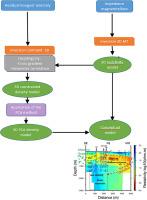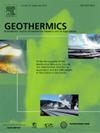三维电阻率模型约束下的三维重力反演:对阿萨尔裂谷(吉布提共和国)Fiale火山口和Gale-le-Koma地热远景概念模型的启示
IF 3.9
2区 工程技术
Q3 ENERGY & FUELS
引用次数: 0
摘要
在裂谷非常活跃的情况下,例如在吉布提共和国,地热系统的特征是复杂的。尽管在过去的几十年里,在公认的前景中进行了大量的地球科学研究,如在阿萨尔裂谷的菲亚莱火山口和盖尔勒科马,我们还没有很好地了解地热资源的机制,它们与深度热源和水补给的关系。为了在这一认识上取得进展,我们提出了一种新的三维电模型指导下的三维重力数据反演分析,以获得每个地热站点的约束密度模型。这些模型和电阻率模型揭示了高度断裂的地下构造主要受两个过程的影响:裂谷的地热活动和活动裂谷构造的构造控制。这些模型与钻孔岩性、地球化学和水文地质资料吻合较好。该研究提出了两个地热系统的修正概念模型。这些概念模型包括每个地点的浅层水库和深层水库(Fiale Caldera和Gale-le-Koma地热勘探区),主要由来自Ghoubbet湾的海水补给,也可能由区域气象地下水补给。本文章由计算机程序翻译,如有差异,请以英文原文为准。

3D gravity inversion constrained by a 3D resistivity model: Implication for the conceptual models of Fiale caldera and Gale-le-Koma geothermal prospects in the Asal Rift (Republic of Djibouti)
Geothermal systems in the context of very active rifting, such as in the Republic of Djibouti, are complex to characterize. Despite the numerous geoscientific studies conducted over decades in recognized prospects such as Fiale Caldera and Gale-le-Koma in the Asal Rift, we do not understand well the mechanism of the geothermal resources, their relationships with the heat source at depth and the recharge of water. In an attempt to progress in this understanding, we present an analysis of 3-D gravity data inversion guided by a new three-dimensional electrical model to obtain constrained density models for each geothermal site. These models along with the resistivity model revealed highly fractured underground structures primarily influenced by two processes: geothermal activity from the rift and structural control from the active rift tectonics. These models are in good agreement with the lithology from boreholes, as well as with geochemical and hydrogeological data. The study presents revised conceptual models for the two geothermal systems. These conceptual models consist of a shallow reservoir and a deep reservoir at each site (Fiale Caldera and Gale-le-Koma geothermal prospects), primarily recharged by seawater from the Bay of Ghoubbet and possibly by regional meteorological groundwater recharges.
求助全文
通过发布文献求助,成功后即可免费获取论文全文。
去求助
来源期刊

Geothermics
工程技术-地球科学综合
CiteScore
7.70
自引率
15.40%
发文量
237
审稿时长
4.5 months
期刊介绍:
Geothermics is an international journal devoted to the research and development of geothermal energy. The International Board of Editors of Geothermics, which comprises specialists in the various aspects of geothermal resources, exploration and development, guarantees the balanced, comprehensive view of scientific and technological developments in this promising energy field.
It promulgates the state of the art and science of geothermal energy, its exploration and exploitation through a regular exchange of information from all parts of the world. The journal publishes articles dealing with the theory, exploration techniques and all aspects of the utilization of geothermal resources. Geothermics serves as the scientific house, or exchange medium, through which the growing community of geothermal specialists can provide and receive information.
 求助内容:
求助内容: 应助结果提醒方式:
应助结果提醒方式:


